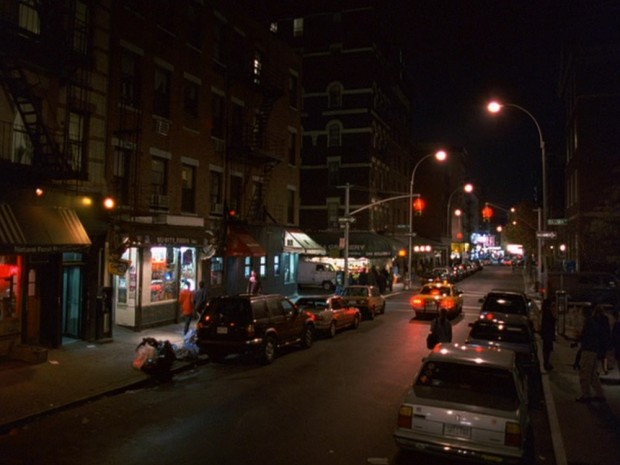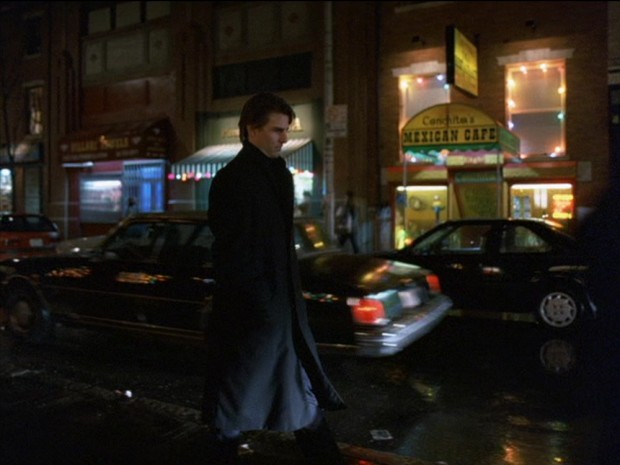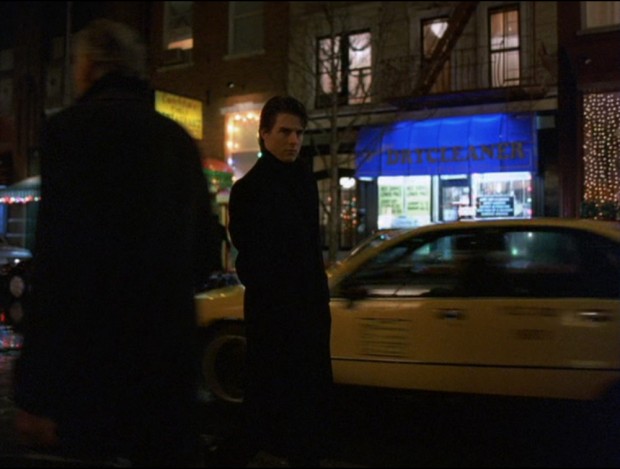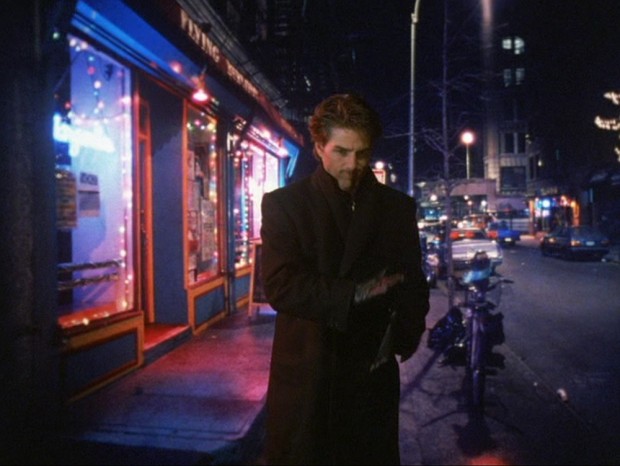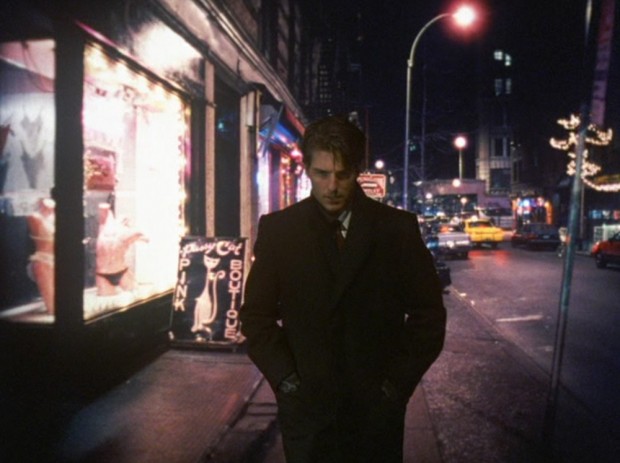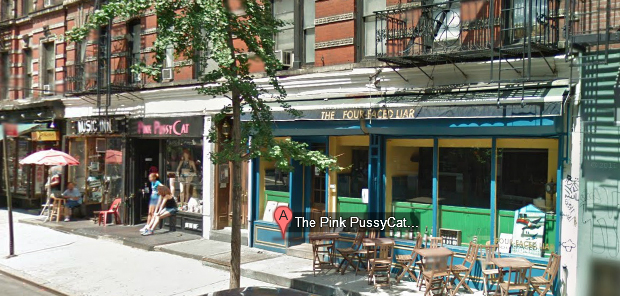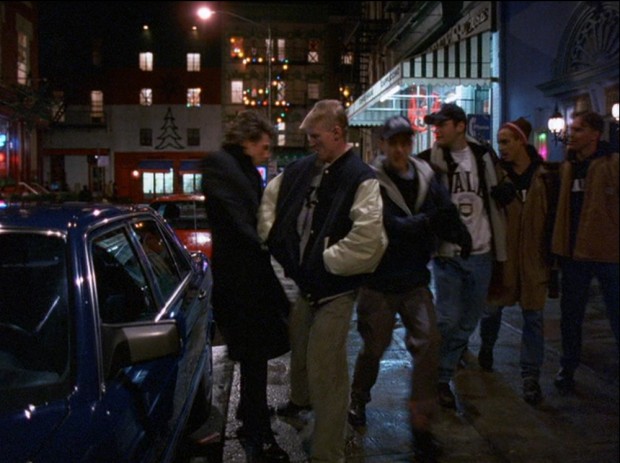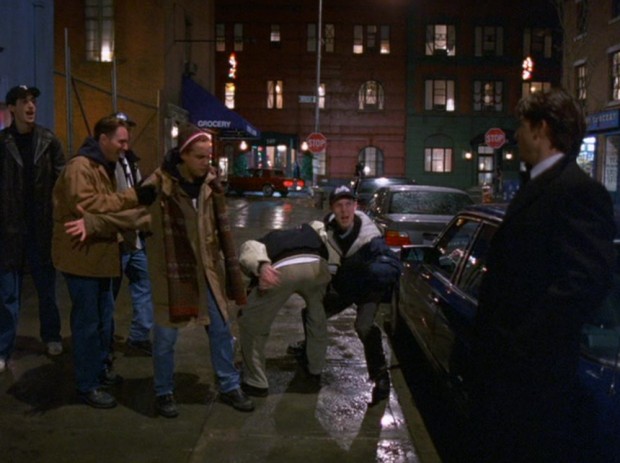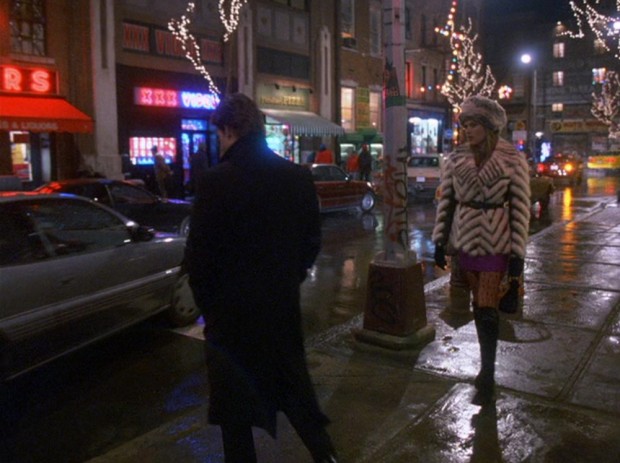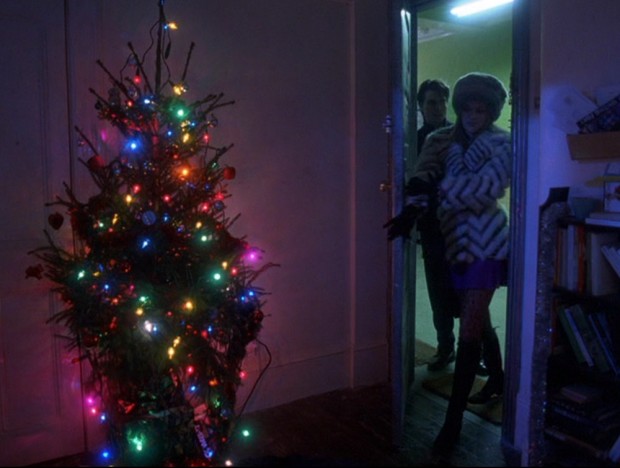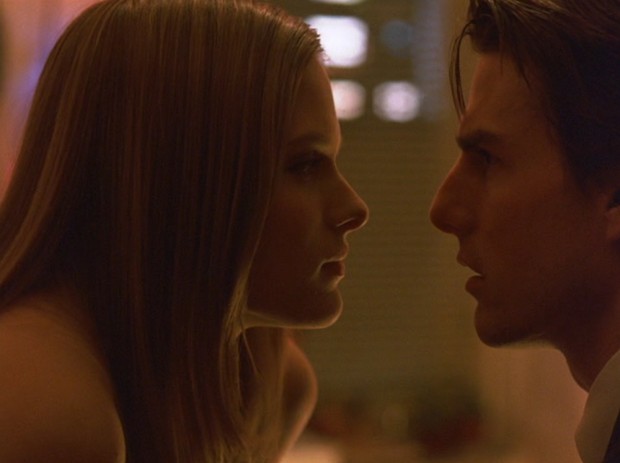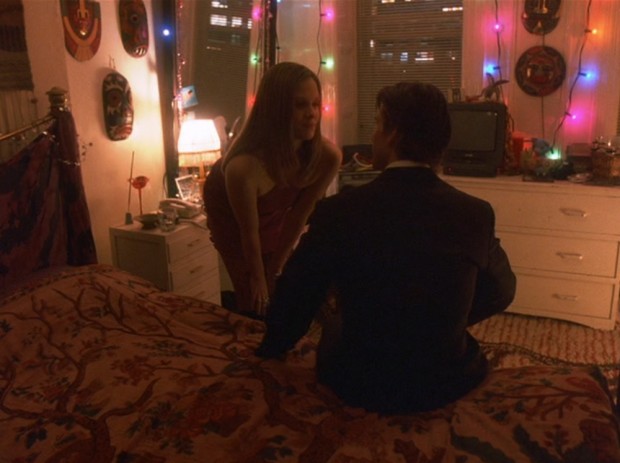STANLEY KUBRICK'S EYES WIDE SHUT

Go to TOC for this film ( (which has also a statement on purpose and manner of analysis and a disclaimer as to caveat emptor and my knowing anything authoritatively, which I do not, but I do try to not know earnestly, with some discretion, and considerable thought).
PART THREE
TOC and Supplemental Posts | Part 1 | Part 2 | Part 3 | Part 4 | Part 5 | Part 6 | Part 7 | Part 8 | Part 9 | Films Home
LINKS TO SECTIONS OF THE ANALYSIS ON THIS PAGE:
Bill's First Pass Down the Hidden Rainbow Street, Shots 164 through 168
The Mexican restaurant. Vitruvian man. Nipped in the Bud. Flying Burrito. The Pink Pussycat.
Bill's Second Pass Down the Hidden Rainbow Street, Shots 169 through 174
Sevens. Sharky's. The Yale bullies accost bill, replaying earlier events. The lost pleiades.
Bill's Third Pass Through the Neighborhood, Shots 175 through 194
Domino. The lotto store and Domino's apartment. Blume in love and Alice's interruption of Bill's escapade.
Eyes Wide Shut and De Palma's Hi, Mom
Comparison of Hi, Mom with 2001. The two apartments. Comparison of the theater of "Be Black, Baby" with Bill's ordeal at Somerton.
BILL'S FIRST PASS DOWN THE HIDDEN RAINBOW STREET
THE MEXICAN RESTAURANT - VITRUVIAN MAN - NIPPED IN THE BUD - FLYING BURRITO - THE PINK PUSSYCAT
SKIP ALL THIS AND TAKE ME TO THE TL;DR WRAP-UP AT THE END OF THE PAGE.
First, here's the the handy-dandy diagram I made up of the streets Bill rambles and the various establishments he visits which are actually multiple fronts.
164 Crossfade to a city street. (45:28 begin crossfade, end at 45:31.)
The crossfade of Bill exiting Marion's residence has him entering a street scene which isn't a view from the set, the streets being open ended rather than closed, but we have an impression of it being the set with the various awnings that echo those of the set. To the left we see a Natural Foods place and further down on a corner a grocery with a large overhanging green awning. We hear a siren. This is 3rd and Sullivan.
Gayle, at Victor's party, had said she'd half of 5th Avenue in her eye when Bill helped her with a clean handkerchief. Bill is now going to get a taste of the same via a veritable flood of symbols assuming meaning via their foreshadowing and relationship to the events he'll experience that night and the next.
165 MS Bill walking down the street past Conchita's Mexican Cafe. (45:34)
We are for the first time now on the studio street set. The pavement is wet, whereas the previous non-set street was dry. On the opposite side of the street we see Village Jewels with a red awning, a pizza place with a green and white stripe awning, and Conchita's Mexican Cafe with a yellow and green awning with green scallops. Next we see the blue awning of a drycleaning shop, then a restaurant with a window filled with a white wall of lights much like was on the wall behind the stairs at Victor's.
Village Jewels is located where Sonata Jazz will later be, and the pizza place where we will later see Gillespie's.
Bill looks to his right. Music begins.
Next to Conchita's is a doorway that is numbered 6. As it is numbered 6 on each side of the doorway, we've a potential 66 here. And above, in the window, we've Leonardo Da Vinci's Vitruvian Man. Perhaps.
Wikipedia relates:
"Leonardo envisaged the great picture chart of the human body he had produced through his anatomical drawings and Vitruvian Man as a cosmografia del minor mondo (cosmography of the microcosm). He believed the workings of the human body to be an analogy for the workings of the universe. "According to Leonardo's preview in the accompanying text, written in mirror writing, it was made as a study of the proportions of the (male) human body as described in Vitruvius. The text is in two parts, above[a] and below the image.
Among the proportions given, a cubit is given as 6 palms that 4 cubits make a man, or 24 palms, and that the measurements are in his buildings.
If you open your legs enough that your head is lowered by one-fourteenth of your height and raise your hands enough that your extended fingers touch the line of the top of your head, know that the centre of the extended limbs will be the navel, and the space between the legs will be an equilateral triangle...
The inner degrees of an equilateral triangle are each 60.
Again, from Wikipedia, courtesy The Whole Universe Book:
The drawing itself is often used as an implied symbol of the essential symmetry of the human body, and by extension, of the universe as a whole.
So we have a possible glyph of the Vitruvian man on a building numbered 6 or 66, the calculated area for the circle being 660 square palms.
If Da Vinci's Vitruvian Man is observed here, we return to the idea of the whole person, the balanced person, which was had earlier with the introduction of the osteopath.
Though we don't know it yet, Bill is walking on the side of the street where we will later see the Rainbow costume shop, passing by where it approximately should be.
166 LS A woman and man kissing before the flower shop Nipped in the Bud. (45:45)
What Bill is looking at--coincidental with our seeing the Vitruvian man--is a couple passionately kissing, leaning against a florescent green colored shop by the name of Nipped in the Bud, street number 280. The green awning above reads Bouquets, Dried Flowers. As with elsewhere, Christmas lights fill the windows. There are also numerous bouquets of red roses, one in a vase on a Grecian/Roman column. Twin neon red rose buds shine in the window. On the door is an FTD fleeting Hermes figure.
The woman wears a white plush coat and red leggings. As they kiss, the man rubs his hand over her buttocks. A St. Nick figure stands behind the window to the side of them, looking out at Bill, like Nick Nightingale with a wink and a nod supplying Bill a door to the later "orgy". And, curiously, in St. Nick we have Alice as well, through her being played by "Nick" Nicole Kidman, who we have seen wrapping presents for the Christmas tree.
As noted, this shop, by virtue of Bill's location when he glances over to it, would seem to be in the approximate location of the Rainbow but is different, it is not the same exterior, and in not being the same exterior it is out of step with the rest of the scenes filmed on this street set.
I was unable to place the location of the florist on the set, as it didn't fit with the building beside the Rainbow, until seeing this below image at archiviokubrick.it.
I had believed that Kubrick intentionally skewed the street numbering system on this pass through. A couple of doors down from Conchita's, the number 6 is prominently displayed, while just across the street the flower shop's number is instead 280. But the florist shop turns out not to be on the street upon which Bill is walking but is instead on Pitman Street, towards which Bill is walking, located next to a building decorated with a large Christmas tree (see the map above). It is realistically impossible for Bill to have this perspective of the florist shop, as if it is just across the street from him. The florist shop is at a 90 degree angle from what it should be. This may seem accidental but these 90 degree angle shifts are sprinkled throughout The Shining and 2001. These 90 degree shifts have everything to do with presaging and making a formula of the The Shining's ending in which Danny reverses his path in the maze, makes a 90 degree angle into the hedge and covers his tracks, thus disappearing from Jack and saving his life. (Even the entrance to the maze shifts 90 degrees.)
Things are continually "nipped in the bud" for Bill, and we see this "nipped in the bud" also in the artistic relief on the wall in Bill's office, the flower without a bloom.
167 MS Alice and the Naval officer. (45:49)
Cut to Bill imagining Alice and the Naval officer passionate kissing, she only partly robed now. She still wears the dress but her pants are around an ankle.

168 MS Bill passing by an establishment with the word "Flying" in the window. (45:57)
Bill continues to walk, now toward the camera. He's on a street that is not from the set.
Behind him we see a Vintage Clothing and Jewelry shop (not Village jewels) and on his left is a neon sign in a window that simply says "Flying". The way the "Flying" neon is positioned it is over a 1960s style flower power LOVE sign on the wall within, and this next to an image of someone playing a guitar. We see in the window a picture of a woman or man that is staged so they appear to be looking out on the street at Bill. We see next a placard out front reading "Ladie's Night 1.00", then a continuation of the establishment in the next storefront window, with a sign reading $3.95 for the lunch special. Again, on the wall directly by the window, is another painting of a woman that is positioned so she appears to be gazing out on the street at Bill.
We finally see on the awning above the name Flying Burritos and on a neighboring awning the word Brothers. This is what was a real Mexican-style restaurant named for the band The Flying Burrito Brothers, I guess.
Bill slaps his hands in a fury as a red flash of light briefly appears in the bottom right of the frame as if underscoring that fury. A cab passes by.
The timing of Bill pounding his hands and the red flashing at the bottom right of the screen seems too perfectly in sync to be coincidental.
Danny, in The Shining, had worn a jacket that read "Flyer", which is initially seen by the audience as reading "lyer". The restaurant or pub here is a similar blue and red to that jacket Danny had worn, which was blue with red stripes.
Also, in The Shining, when being shown around the lodge upon her arrival, Wendy, Danny's mother, had made mention of the frenetic activity as everyone made preparations to leave. When she was told that by 5 o'clock the place would be empty, she had replied, "like a ghost ship". Such as the Flying Dutchman? A ship that sails the seas forever (or until Judgment Day), appearing out of the mist, never finding port. I don't see a relationship between either of these things and Eyes Wide Shut but there may be.
The waltz that began the film was played by the Concertgeboux Amsterdam. There had been duplications of Vincent Van Gogh's sunflowers embedded in a painting in the kitchen and the tub of "I can't believe it's not butter" below acting as perhaps a commentary. Alice had wrapped a Van Gogh book, perhaps as a present for Bill, the cover positioned so the eyes of Van Gogh's self portrait confronted the eyes of the audience, just as we've had these several images of people gazing out of the the Flying Burrito on Bill and the audience as he passed by.
When Bill slaps one hand against the other, he is passing a door with half-circle arch above it. He next immediately passes the Pink Pussy Cat Boutique. In the shop window, outlined with white lights, is a white neon 5 point star, a torso of a male mannequin in black briefs and a female torso mannequin in lingerie. The number 77 may be in the shop window preceded by another number, or something like it. This is an actual shop in New York city. The Pink Pussycat is located at 167 West 4th St. in New York. We are looking toward 6th St. and the Avenue of the Americas down 4th.
The Mexican restaurant, Conchita's, in the former scene, had been followed by the sexy kiss on the sidewalk before the Nipped in the Bud flower shop. We have rather the same formula here, though this time it's a sex shop following the Mexican restaurant. Conchita's was on the set and the building that houses Conchita's will wear multiple facades, including James Tobias Lomas Realty. Kubrick chooses then to sandwich in a real street from the Village in New York. Though the scene is also not "real" in that Tom Cruise has been filmed before a blue screen and so is not actually walking before any of these Village shops.
At the end of the street, in the distance, we see a structure that isn't present on Google street view.
Bill passes the metal grating of a Music Record shop which has an image of a camel hanging down. I immediately think of GML, the letter which corresponds with the camel, its number being 3, and how the camel serves to carry the traveler across the spiritual desert of the abyss.
After this brief real Village segment, against which Bill appears courtesy of green screen, Kubrick returns to the constructed set.
BILL'S SECOND PASS DOWN THE HIDDEN RAINBOW STREET
SEVENS - SHARKY'S - THE YALE BULLIES ACCOST BILL, REPLAYING EARLIER SYMBOLS AND EVENTS - MOURNING BECOMES ELECTRA? THE LOST PLEIADES
169 MS Bill passing a grocery store. (46:08)
The manner of the cut is such that we're intended to believe Bill has just passed the record shop. He is, however, now on one of the studio set's streets and has just passed a book store, all we are able to see of the sign being "The BO..." but there are books viewed through the windows. This brings in a variation on the several libraries viewed in the film, the first being when he was in the dressing room, the last when he is in Victor's pool room.
He now passes before a small grocery store with a Schlitz sign in the window. Ajax laundry detergent is being sold for 1.99 and Vegetables 3 for a dollar. Gelatin is also sold, 4 for 88 cents.
He takes a corner, turning right onto the hidden Rainbow street.
At the far end of the street is a tricolored building, its first floor painted red, second floor white with a Christmas tree outline in 4 stages, and the upper portion being brick. Next to that is a store with a green and white awning. The fire escapes above are decorated with lights in such a way it looks like a 7 over a 7, or a 77, or maybe it's a great big 3. My first thought was 7 as after this, during the encounter with Domino, we will again see a number of 7s, reminding of the painting back in Bill's office in which a figure had been looking toward an archway under which appeared to be passing at least two figures shrouded in red, the scene painted in such a way that a 7 appeared to hang over them.
The Nipped in the Bud shop was in the place of the shop under the fire escape lights discussed above.
Via Victor's wife being Illona, a variation of Helen, and because of Cupid and Psyche, twinship ideas exhibited in them, I had brought up Helen and her twin Clytemnestra, and their brothers, the twins Castor and Pollux, in section one. Also, the movie Helen of Troy is observed in the Harford bedroom.
We have just passed the shop window in which was an Ajax sign. Ajax was a semi-divine warrior of Agamemnon's. When Ajax was deprived of Achilles' armor, after the death of Achilles, and it was instead awarded to Odysseus, he plotted to kill Agamemnon and Odysseus as he believed himself disgraced. Athena deluded Ajax into believing sheep and cattle were the Greek leaders, and Ajax killed these substitutes instead. When he woke from the episode of deity-inspired insanity, covered with blood, Ajax erroneously believed he had killed Odysseus and Agamemnon--or so it goes in Sophocles' play. So, what Ajax had observed was not actually what was there, and all due the goddess' intervention. But he acted as if, and that was psychically almost as good as doing the deed. What is real and what is dream is a concern of the film, and that no dream is ever just a dream, nor does reality tell the whole truth. The myth would seem relevant to the film. Bill later comes to believe that, due his supposed trespassing at Somerton, he is the cause of the death of a prostitute, that she is killed for him, a belief of which Victor will attempt to dissuade him.
Still passing the grocery store on his right, there is an open phone booth and a couple of racks for dispensing papers, one is red with a Marlboro sign, and the other is yellow with a New York Post sign. The blue awning reads Groceries but faint vestiges of the letters FRE (or FAE) immediately precede, as if they had not been completely removed. As if, as with Ajax, what is presented here is not what initially was or really is.
Below is a highly pixelated extreme close-up.
Next the grocery store is an entrance with the number 7 beside it. Then we have an empty lot and a blue building decorated with an arch frieze. On the side of the blue building we're able to view the large painted sign "Everything Electronic for Less! 555-1121. Thank You. I Love you!" A couple of red hearts border.
The "I love you!" sign reminds of Marion's declaration of love that she has just made to Bill, only now coming at him from a painting on a building, the declaration following him and finding life in his environment.
One has to admit it is rather odd for a business to make a declaration of love on a sign for electronics--supposedly a thank you for customers, but in this manner, and with hearts? This is out of the ordinary. It's not usual. It's not every day. It's a cue that something is very out of place here.
Next after that is what will later be the Rainbow costume shop but is instead here a Cappuccino shop with a green and white awning. Toward the end of the film it will be Sharky's, and we can even see, above the awning of the Cappuccino shop, part of the Sharky's lettering. Below is a extreme close-up comparison.
Just as Bill rounded the corner, a group of men had also rounded the opposite corner and are walking toward him. We can hear them from all the way down the street.
COLLEGE KID: ...my face! Listen to this. She had a red rose in her mouth. She was doing a Mexican lap dance right in my face. I'm serious. I've got scars on the back of my neck.
The college kids see Bill.
COLLEGE KID: Hey, hey, hey, what team's this switch hitter playing for?! Looks like the pink team. Faggot!
One crashes into Bill as they pass, knocking him into a car.
170 MS Bill slamming into car and nearly falling. (46:27)

Having just left Marion, who had grasped Bill by the back of the neck in her kiss, he is addressed as Mary (same etymology), a homonym of "merry".
By the way, that big cat painting in Bill and Alice's gallery? It's "Polly" by Katharina Kubrick. Polly is a diminutive of Mary.
COLLEGE KID: Faggot!
COLLEGE KID: Merry Christmas, Mary!
171 LS The 6 college kids. (46:32)
COLLEGE KIDS (slapping the ass of one): Your butt brothers are back there. Prime cut of meat, baby! You want to take a ride in this fudge tunnel, you stupid faggot?
172 MS Bill staring after the college kids. (46:38)
COLLEGE KIDS: (Can't discern what they're saying for a couple lines.) You should have tits, you're standing so close. I got dumps...
173 LS College kids. (46:42)
COLLEGE KIDS: ...that are bigger than you. C'mon macho man! C'mon macho man! You wanna piece of this, baby? Exit only, honey!
Just as we have this replaying, in spoken word, of what Bill had earlier seen (the rose and the kiss etc. following after the Mexican restaurant), we are also returned to the "Fright Before Christmas" cartoon with Speedy Gonzales, the Mexican mouse who wears the costume typical for the running of the bulls. We can see here a Speedy reference (the Mexican) and look upon the "prime cut of meat" as referencing the bulls (or steers). These men, as the bulls, have just rammed Bill into the car. Even the "exit only, honey" can be seen as referring back to the bottle of bear honey on the breakfast table during the cartoon scene.
174 MS Bill. (46:50)
COLLEGE KIDS: Go back to San Francisco where you belong, man!
I have already brought up the troubadours. St. Francis (perhaps associated with the San Francisco reference here) was a follower of the troubadors, who some believe practiced the green living language of the birds, which may be a reason why St. Francis is associated with the birds in legend, given as speaking with them and understanding them and other animals. I hold that it's possible Bill is presented with a kind of living language in the film, communicated by symbolism etc., a double language continually acted out and staged about him, and the St. Francis reference could fit in. Bill certainly does speak with one "bird", Nick Nightingale.
But I have also discussed how Bill and Alice live at San Remo in New York and there is a San Remo also in San Francisco.
Several of the college boys wear shirts that read Yale but only the AL is usually visible. One has a 6 also on his shirt.
Bill stares after the college kids until they are gone, then turns and continues down the street past what will later be the Rainbow.
So, things Bill had seen, actions he had made, are being played out in this altercation. He had just passed a Mexican restaurant named Conchita's (a version of "conception" to go with the ideas of pregnancy and birth in the film), when he had seen a couple making out under a rose--and if you look back at the photo you'll see how, with the florist shop scene, it looks as if the rose is in the woman's mouth. At Marion Nathanson's (Marion being a variation of the name Mary--and, as already pointed out, she had eagerly grasped the back of his neck in her kiss) the maid had been Rosa, and Bill's own babysitter was a Roz. After passing another Mexican restaurant, he had pounded his own hand in fury or exasperation as he walked by the Pink Pussy Cat Boutique (pink team). It's as if that aggression, Bill pounding his own hand, is now being played out by these individuals who slam him against the car as the bulls ram the bull-runners and call him a switch hitter.
They make suspect Bill's sexuality, as if giving him reason to pursue an infidelity in order to prove himself sexually, Kubrick perhaps even taking advantage of the public's long-held suspicion that Tom Cruise is gay and closeted, meshing and confusing real gossip with the stage.
The display of the man's posterior may find its parallel also in the focus upon Alice's buttocks when she was putting on her bra while dressed only in black knee socks, which gave her a slightly dom look. She too was bending over with her posterior displayed for the camera. Before the florist shop, the man had been fondling the woman's buttocks.
A switch hitter. It has perhaps instead to do with the switch that happened in 2001 when HAL declared his chess move from Frank Poole's "white" position rather than his own "black" position.
In the book, the collision occurred with members of the Alemannian fraternity, and caused Fridolin to question himself as far as youth and strength, his reluctance to fight for fear of what might happen, always projecting into the future with a domino effect of what-ifs. Oddly, the man who had bumped into him had a black patch over a white bandage on one eye, which was kept in the Traumnovelle film by Glück but has been dispensed with by Kubrick. I don't know if Schnitzler and Glück had intended the audience to consider that the one-eyed man's depth perception might have been skewed and the physical altercation accidental. In nearly all of Kubrick's films an eye examination of some sort takes place, often a light being shined in the eye, so it's interesting that Kubrick foregoes the eye injury, and that in Eyes Wide Shut, which has the "eye" in its title, he seems to choose to fulfill that theme with Bill's looking in Mandy's eyes for responsiveness in Victor's bathroom, and perhaps the eye exam poster in shots 62 and 64.
Returning for a moment to the "electronics" ad that declares "I love you!", which is seen during this collision.
One may recollect that, via the mortal and deity pairings of twins found in the joint myths of the twins Helena and Clytemnestra, and their twin brothers Castor and Pollux, I had already brought up Electra exacting revenge on Clytemnestra, her mother, and her stepfather, Aegisthus, for the murder of Agamemnon, Clytemnestra having killed Agamemnon in vengeance for his having sacrificed (in some versions) Iphigenia, a sacrifice which purchased for him safe passage to Troy.
Sirius was the dog of Orion (Orion was one of the ships in 2001, actually), the mighty hunter who is said to have pursued the seven sisters, the Pleiades. In order to enable their fleeing him, they were transformed first into doves, then into stars. Electra was one of their number--yet another Electra, mother of Dardanus who founded Troy, and her grief over the destruction of Troy was such that she withdrew her light and disappeared, becoming the lost Pleiade. So, both Electras are involved with Troy.
If we return to Marion's encounter with Bill, when he has denied her and Carl arrives, she asks him to please not despise her. The etymology of despise is "de" (down) and "spicere/specre", meaning to look at. The word telescope, with which one examines the stars, derives from this. Just for fun, I've played with the idea that "Electronics for less", declaring its love, connects Marion with Electra as the lost Pleiade. That seems a stretch but it's a hell of a lot of fun stretch to consider.
The Hebrew word for the Pleiades was Kiymah, from the same as kuwmaz, "from an unused root meaning to store away; a jewel", a tablet. In other words, something hidden and precious. Has this to do with the hidden Pleiade, Electra withdrawing her light?
Later, when Bill calls Marion, as if testing what has happened or thinking of indeed pursuing her, she has disappeared, Carl instead answering the phone. We don't see her in the movie after the scene in which she professes her love. But Marion is associated with a pattern in the movie of people who vanish when Bill, on his own initiative, looks for them his second day out. Nick eludes him. Marion eludes him. Domino eludes him.
My thoughts on Electra may seem far-fetched. No denying it. And though this may seem absurd, and perhaps is, I take this direction because I'm looking at the use of names, imagery, puns that can be connected with, ultimately, the mazes of Troy and Jericho, which I will discuss in greater detail in the section on the "orgy" at Somerton. What actually could fit, and fit by intention, I've no idea. Maybe none of this! But Kubrick, in my estimation, is working with, among other things, maze ideas that have to do with Jericho and Troy, which I think becomes increasingly firm with the visit to Somerton.
Just as the set buildings that form the maze have multiple facades and yet their alter incarnations are not always completely obscured, it's entirely possible that language could be used in this fashion, like layerings of clothing.
This area is inscribed with unintelligible graffiti, language that has grown so baroque and decorative that its meaning is obscured but to the initiated. The outsider doesn't understand it.
The film just seems inclined to etymological explorations, digging down to the meaning at the root of words that have morphed over time.
 172 |
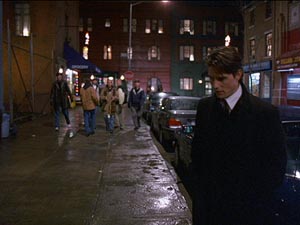 173 |
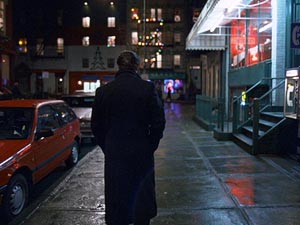 174 |
|
BILL'S THIRD PASS THROUGH THE NEIGHBORHOOD
DOMINO - THE LOTTO STORE AND DOMINO'S APARTMENT - BLUME IN LOVE AND ALICE'S INTERRUPTION OF BILL'S ESCAPADE
175 LS City street. (46:59)
If we compare this view to the other non-set view of a city street opening this section, they seem similar because in both, on the left corner of an intersection, we have a brick building which has windows bordered top and bottom with bars of white, then across the intersection in both is a building with a large awning. The building with the awning in the former pic was a grocery, while this one appears to be a bar or a restaurant. On a left wall we see a sign that reads BACK FENCE (a bar) but looks here like BACK FDGE. On the right we see a CVS. In the foreground right is briefly observed a man walking toward and under the camera with his hands at his neck, an action which echoes the college kid speaking about the scars on his neck from the Mexican lap dancer.
The Back Fence is at 155 Bleecker Street in Greenwich Village.
176 MS Bill walking past a bar decorated with stained glass, and a man on a phone. (47:03)
Bill passes a bar with three arches in front but it is the same book store as in shot 169. He is geographically back at the beginning of the previous scene in which occurs the collision with the Yalies, and the area will reveal yet another face.
We hear a man getting off a pay phone who glances at Bill as he passes.
PAY PHONE MAN: Oh, I see, I'm taking care of it baby.
The grocery store which was on the corner of the hidden Rainbow street is now a hardware store, its window filled with adverts and signs for hammers, master locks, keys, electrical supplies, super enamel, paints, prints, brushes and hardware. Illegible graffiti is spray painted on the corner of the building.
A visual pun is perhaps had here which plays off the idea of the lap dancer leaving scars on the back of one's neck (presumably from her nails). Hammers pound nails and as Bill passes the hardware store we briefly see the largest hammer poised as if to hammer a nail into the back of his neck, a visual pun on the Yalie talking about having scars on the back of his neck from the lap dancer, implying her digging her nails into the back of his neck.
As Bill approaches the corner we observe a woman in a gray fur hat and black and white stripe fur jacket takes notice of him.
Bill stalled on the corner by traffic, we see down the hidden Rainbow street to the right (he will not be walking in its direction this round), on the opposite side, a liquor store, then a xxx video store where Sonata Jazz will later be located and where Village Jewels was previously, and a pizza shop where Gillespie's will be and where a pizza shop was previously (see shot 165). At the end of the street, on the building where was the painted Christmas tree in shot 169, we see instead a painted advertisement for sewing threads. Sewing thread had been resting on what was perhaps a bag of Roz's the prior night as Bill and Alice said goodbye to their daughter and the babysitter on their way out.
Here enters the labyrinth, just as had in The Shining, Bill making his way through the maze in his Dionysian initiation, Ariadne being not only the mistress of the labyrinth, providing Theseus the thread by which he might find his way back out, but being also a consort of Dionysus.
I'm going to go ahead and crib here Wikipedia's notes on Ariadne, the labyrinth, the Dionysian rites, masks and theater, because it's all pertinent, explained rather well in an abbreviated fashion, and because we are about to meet Domino, whose bedroom wall will be covered with masks, and whose name has a relationship to the hooded cloak worn by priests and a domino which is also a style of mask.
The mystery religions consisted of a series of initiations, benefiting the individual or their society. Initially associated with puberty, they later became an evolutionary rite. It was in the form of a mystery religion that the cult of Dionysus evolved, probably in the civilization of Minoan Crete. The rationale for the Dionysian Mysteries was to affirm the primeval, bestial side of mankind, while integrating it into civilization. The dual role of Ariadne (as Mistress of the Minoan Labyrinth and consort of Dionysus) and the Minotaur story may derive from the mastery of mankind's animal nature. The self-mastery thus achieved was not one of domination, as in similar cults (George and the Dragon, and the original Minotaur myth), but one of integration. While the Mysteries lightened the cult's darker aspects, they failed to reassure its civilized critics and were regarded as dangerously liberative (particularly in their egalitarianism).
In Athens, spiritual possession was channelled into dramatic masked rituals within the Bacchic Thiasos (Greek equivalent of a coven or lodge), sowing the seeds of acting and theatre-crafts sacred to Dionysus, in the forms of tragedy and comedy. The Dionysian Mysteries were seen not only as recognizing and casting off the repressive, over-civilised masks all humans wear and the realisation of true human nature--the creation of new, authentic masks, the deeper function of drama and comedy (in other words, the development of genuine character rather than a socialised persona). In time, as Dionysus became less bestial and more mystical with the general shift of pagan orientation, this was viewed as the preservation of the soul and the survival of death. These themes would become central to the later Orphic manifestations of Dionysianism that would influence early Christianity (according to Roman commentators, but denounced as a devilish mockery of Christ by Justin Martyr).
Article at Wikipedia
Domino wears a short purple dress, purple lace stockings and knee high black boots. As Bill begins to walk into the street then steps back out of the way of a cab and waits for the traffic to clear, she approaches.
DOMINO: Excuse me. Do you know what time it is?
BILL (looking at his watch): Ten past twelve.
In shots 141 and 143 we had been shown the time was 1:22 when Bill was on his way to Marion's. Now it is only 12:10.
177 MS Domino and Bill on the corner beside the hardware store. (47:23)
DOMINO: Going anywhere special?
BILL: No, I'm just taking a walk.
Domino smiles, following Bill. As they cross the street we view the hardware store behind and the right side of the hidden Rainbow street. The neon sign for the hardware store shows "All Day Hardware" and has in rainbow hues the word paints. Hanging from the store is a sign with a paintbrush that reads "Muralo Paints". Next to this building is an empty lot, which had been the empty lot in shot 169, then next the empty lot is the building with twin globe lights on which we see still the "electronics for less" sign. Then next door to that we see even what will be the Rainbow costume shop, but now its windows are empty and no lights burn except for blue ones in the lower level.
DOMINO: How'd you like to have a little fun?
BILL: I'm...I'm sorry?
DOMINO: Have a little fun?
She steps before him, slowing him, as they pass a corner market before which are trash bins on each of which is the number 80. The street number is 271.
They pass a man speaking on a phone beside a hotel.
DOMINO: I just live right down there. Would you like to come inside with me?
BILL: Come inside with you.
DOMINO: Yeah.
They pass the Original Josef Kreiber Knishery, building 269, then The Lotto Store. They stop before a building with bright red doors, number 265.
DOMINO: It's a lot nicer in there than it is out here.
BILL (nervous, in a curiously choking voice): You, you live in there.
DOMINO: Yes.
BILL: By yourself?
DOMINO: No, I have a roommate but she's not home. Hey, it's okay. (She takes his arm, reassuring.) No one will bother us. (She pulls him toward the steps.) It's okay. C'mon. C'mon.
Bill follows Domino up the stairs. As they reach the door another woman passes in front of the camera who wears a hat similar to Domino's, which is a Russian fur style hat. This brings to mind the waltz music used in the opening which was from The First Echelon, a title taken from a style of Russian warfare in which there are so many simultaneous and diversionary assaults that the defense has no idea what the objective is and thus fails.
They enter building 265, the audience perhaps thinking that after being called faggot, maybe the shocked Bill is resolved to prove he's not, or perhaps he's taking up with the prostitute in response to his wife's confession. I personally have a problem with the idea that Bill's manhood is so threatened by his wife's confession and the frat boys that he would take up with the first prostitute he meets, he obviously seeming to have not been with a prostitute before. But, yes, Fridolin did go with a prostitute in the book (who wasn't named Domino), and Kubrick has kept close to the book in having Bill's encounters with Marion, the frat boys, and now the prostitute.
Another thing to possibly consider is that, directly after Bill having been pushed into the car by the men who accused him of being a "switch hitter", a faggot, he has met this supposed prostitute who is inviting him into her apartment next to a building in the windows of which Lotto was advertised, and hence one could be reminded of the Lot of Sodom and Gomorrah, not only due the homophone but lotto and the prostitute occurring in the story line after Bill being attacked and scorned as a "faggot", Sodom being, after all, the source for the word sodomy. (Yes, I know this seems a stretch.) LVT, meaning a veil or covering, is also related to LT which means, private, secret, incantation. Because of the biblical Lot taking in the messengers of god, he was spared when the cities were overturned. Nearly the entire time that Bill is in Domino's apartment we can hear not only cars passing in the street, but sounds of clanking, a car starting, men talking outside, a general exterior commotion that is absent in other interior scenes.
Am I sold on this? No. While looking at mythic associations, it is simply another myth to consider.
A maze of myth and simultaneous diversions so the defense has no clear idea of the objective.
One reason I have considered it is due the idea of the violent "overturning" of these cities, and that when Bill returns the next day the Christmas tree looks like it was oddly overturned, its branches in peculiar disarray, and Domino is gone as she has learned she has HIV. Earlier, we saw at Bill and Alice's place a painting titled "Bonfire Night" along with one titled "Gifts from Tourists". The bonfire could refer to the fire and brimstone that rained on Sodom. Bill is behaving also as a kind of tourist, and of all the people he meets this night, it's to Domino he later returns with a present, only to find she is gone. Tourist, from tour, has in it the idea of "a turn, trick, round, circuit, circumference". Sodom and Gomorrah were of the cities of the plain, plain being kikkar, which comes from a word meaning "circle".
Kubrick harnesses the power of myth in his films. Lilith is called up in Lolita (by Nabokov as well). The stories of Abraham and Isaac, and Essau and Jacob are referenced in The Shining. Iphigenia and Aeneas in Barry Lyndon. These are just a few. I'm thinking out loud when I mention Lot, just showing how I consider different things and some of the reasons why.
178 MS Interior hall of building 265. (48:36)
The entrance door of building 265 from the inside. It is adorned with gold and red Christmas decorations. A warning is on the door to keep it closed at all times and not let anyone into the building without identification. This is a little funny, as Bill, who uses his ID throughout the film to gain entry into places, never uses his ID when entering 265. He doesn't use his ID here, invited in by Domino. When he later returns, he gains entrance because another woman is exiting.
The upper walls of the hall are a sickly florescent green, the same green as the Nipped in the Bud florist shop before which he earlier saw the man and woman kissing, the same green as was the light in the elevator at Marion's, where a kiss was interrupted by Carl. The lower part of the walls are a pink flesh colored tile bordered in black. The doors and stairs are painted gray. Behind a gate to the side of the stairs is trash and storage. In the other corner is a blue stroller, which reminds of the painting of the pregnant woman. Not to mention it's Christmas when the birth of the solar deity is celebrated. We view a bike locked to a radiator. Domino goes to the right to unlock the door to apartment 3, beside apartment 2.
179 MS Interior Domino's apartment, Bill and Domino entering. (48:50)
Domino and Bill enter her apartment which is lit up with a shaggy, ill-formed Christmas tree.
DOMINO: This is it.
BILL: Nice tree.
Domino laughs as she passes through the room and cuts on the kitchen light.
Domino's building is in the middle of the block and there are no alleys between the buildings. The bottom level of the next building over is The Lotto Store, and that begins just beside the red door entry to building 265. Which means that there is no apartment #2 as The Lotto Store occupies it. The store is deep enough and its ceiling high enough that it would consume all of apartment 2, and perhaps a portion of apartment 3.
In Domino's living room, not only is there a door that should open on apartment 2, as they pass through the living room we briefly glimpse a window in the screen left wall of the living room which provides some night blue illumination, a window that is impossible. The footprint for Charlotte's house in Lolita is as absurdly impossible, just as the footprint for the hotel in The Shining is impossible, and so too will be the Rainbow costume shop and the Harford apartment. From at least Lolita on, the interiors of the haunts of Kubrick's characters have nothing to do with what we see of them on the outside. In Lolita, Kubrick even has Humbert and Lolita traveling through South Dakota when they are instead supposedly in New England, and I cover in my analysis of that film the possible reasons for this. Impossible layouts in Lolita end up connecting with The Shining, Kubrick referencing Charlotte's home at the Overlook. If nothing else, we have the magic of misdirection making the absurd "real" for the audience.
Domino leads Bill into the kitchen, apologizing for the mess, "Maid's day off," moving a dirty pan, and as he stands in the doorway Bill's expression is one of barely concealed horror of the small, dirty apartment. A tub is in the room filled with presents with an odd, single gold shoe resting on one of them. Red and white bras hang above. Dirty dishes and an open peanut butter jar sit on a table. Christmas cards hang on the walls.
What was possibly a single gold shoe had appeared to be resting among Bill's shoes in the dressing room at the film's beginning.
The cupid that hangs above the bathtub takes us back to the angelic kiss statue at the Ziegler's party. The bathtub could be referring back to the bathroom at Ziegler's mansion, where Bill had attended to the prostitute, Amanda.
A pizza box in the tub is possibly from the pizza place from around the corner, located where will later be Gillespie's diner.
DOMINO (transferring a dirty skillet from the table to the sink): Uhm, sorry about the mess. Maid's day off.
Marion had a maid. Domino does not.
180 MS Domino from Bill's left, facing her bedroom. (49:11)
Bill looks into the bedroom as Domino deposits her keys, bag and belt on the table.
When we switch views from shot 179 to shot 180, there is a slight rearrangement of packages in the tub, and a St. Nick card that had been hanging beside the cupid is missing. What had been a light blue towel is now a red towel. The winged cupid, in a sense, seems to override St. Nick, with Nick disappearing. When Bill returns later, it is the St. Nick card that will be the background card focal point. When, in a minute, Alice (Nick, Nicole) calls Bill, another St. Nick card will be apparent on the wall, as if dominating and overriding the winged cherub.
Domino begins removing her hat and coat, revealing a purple dress cut so it has a choker piece for a neck attached to it. "Cozy, cozy place," Bill says, sitting on the edge of the tub.
In The Shining, Jack Torrance, having been shown the rundown suite in the huge lodge that he and his family would be staying in, had remarked, "Cozy." Also, when shown the suite, Jack glancing at the bathtub, the shower curtain had moved, which was unnoticed by both him and Wendy, presaging the horrors awaiting in Room 237, a hint of sentience of environment.
Returning for a moment to the encounter Bill had with the college bullies, the scratches mentioned on the back of the neck reminded me not only of the strangling sphinx (who makes an overt appearance in A Clockwork Orange, two statues of the sphinx outside the cat woman's house where Alex is temporarily blinded by his buddies with a smashed milk bottle), but of Marion with Bill, her hands on the back of his neck as she made her confession of love. Then, later, prior Bill's collision with the bullies, the feline had been raised again via the Pink Pussycat.
But, in the entry corridor at the home of Bill and Alice, is also the large painting of the calico cat.
As one who strangled her victims, "sphinx" is believed by some to come from the word "sphincter". From the beginning of this evening's events, nearly all the women will wear chokers. Marion wore a choker, Domino wears one, all the women at the "orgy" will wear chokers. One could look upon Bill as surrounded by riddling sphinxes and the connected Oedipal myth of predestination versus free will, which is certainly present in this film as it is in all Kubrick's films.
Another possible link here with the Cat Woman scene in Clockwork Orange is via the clothes line with the bras. One painting in the Cat Woman's exercise/yoga room shows a woman with her mouth gagged and her breasts highlighted, which intentionally recalls the cutting away of the cloth of the red jumpsuit of the "Home" rape victim, her breasts exposed. Another painting shows a figure in attire very similar to what Alex and his Droogs wear, and I think is supposed to represent Alex. A peculiar line hangs above him and from it dangle breasts held by pins (one also has perhaps a sense of photographers hanging photographs to dry). Those remind me of these bras on the line. Beneath that line lies a nude woman, legs spread, wearing thigh high red boots, swinging the much smaller Alex figure around by one leg. The woman has a double mouth with two sets of lips and teeth and hollowed out white eyes from which blood pours. When Alex slams the penis sculpture down on the Cat Woman's open, screaming mouth, Kubrick cuts to the double mouth of the painted woman.
The conversation Bill has with Domino, who never does reveal her name to him, at least not in any of the scenes shown (her roommate later does), is presumed to be a transaction between a prostitute and client, but it's actually pretty ambiguous. We've been speaking previously of shadow languages, dual languages, double entendres, and the covert, never explicit dialogue of the prostitute and client is a continuation of that. As Domino says, "I'd rather not put it into words."
BILL (sitting on the edge of the bathtub): It's uh cozy. (Cheerily.) Cozy place.
DOMINO (shrugs): It's okay.
BILL: So, uhm, do you...do you suppose we should talk about money?
DOMINO (has removed her coat and laid it on a chair): Yeah, I guess so.
Bill laughs.
DOMINO: That depends on what you wanna do. What do you want to do?
BILL: Well, uh, what do you recommend?
DOMINO (giggles, as if disbelieving): What do I recommend? Uhm...hmmm...well (she begins to remove her gloves) I'd rather not put it into words.
Bill laughs.
DOMINO: How about you just leave it up to me?
BILL (relieved): I'm in your hands.
DOMINO (removing her jacket): Okay. And how does a hundred and fifty sound?
BILL: Sounds wonderful.
DOMINO: Don't worry. I don't keep track of the time.
The assumption is that Domino wouldn't want to express in words what she would recommend, but through this we are also returned to the idea of communication by symbols and things other than language, or of obscuring through dual multiple meanings. Kubrick emphasizes this in the next scene, through the movie that Alice is watching.
181 MS Alice in the Harford kitchen. (51:00)
Cut to Alice at home, sitting at the kitchen table, eating SnackWells devil's food chocolate snack cakes, drinking milk, smoking, watching television. On the TV screen we first see a number of pigeons then a waiter in white jacket and black tie serving a table, the customer saying "Thank you", the waiter replying "Prego, prego," the man replying, "Grazie." the waiter replying, "You're welcome sir," a voice over saying, "If I was Italian he would have answered me in Italian."
Again, multiple languages. Prego, though meaning "you're welcome" in Italian (also, "prayer"), is slang for pregnant in English, reminding of the pregnant woman in the painting above Victor's tub in his bathroom. In Blume in Love, Blume has several encounters with this waiter in which the waiter asserts, "Prego, prego," then finally at film's end the waiter is present when Blume reunites with is pregnant former wife, Nina, she goes into labor, and the waiter directs them to a hospital. So it seems that Mazursky may have intended "Prego" to foreshadow Nina's pregnancy.
The white coat and black tie of the waiter remind me of Nick Nightingale.
But I should speak more about the film Alice is watching. It is Blume in Love - A Love Story for Guys Who Cheat On Their Wives about a divorce lawyer who cheats once on his wife and she catches him and divorces him. Finding himself divorced from his wife, and still being in love with her, he ventures to win her back.
Which is Alice's television kind of letting her in on what is currently transpiring with Bill. He's preparing to cheat.
The scene played here from the Blume movie concerns, as I've already noted, language, communication, Blume, who is American, being waited on by a man who is Italian. Blume addresses the waiter in English. The waiter replies in Italian, but when Blume responds in Italian the Italian responds in English, reluctant to converse in Italian with a non-native speaker.
I've written of the language of the signs Bill passes, certain subsequent events which happen playing out those signs. If Bill notices, in some respects it is a conversation, but one sided, it right now seems it's a conversation in which Bill is powerless to take part. Such as the men on the street whose talk had replayed symbols in the film.
Bill's conversation with Domino ends up being stilted by virtue of the reluctance of either to speak freely, all being in cloaked terms, because, for one thing, prostitution is against the law and the prostitute may have felt it safer, for what if Bill turned out to be vice squad?
So did the emperor carry on a secret conversation with the nightingale. "I only ask one thing," the nightingale said to the emperor at the story's end; "let no one know that you have a little bird who tells you everything. It will be best to conceal it." Which was an odd request as in the Hans Christian Anderson story the bird simply sang to the emperor, its music dispelling the faces of death looming, returning him to health.
In Blume in Love, as Segal states, "If I was Italian he would have answered me in Italian", the camera pans right over a young blond man who had been eyed earlier, during a monologue by Segal on love, by a much older man, and had spurned his glance, the scene an obvious reference to Death in Venice in which a composer goes to Venice and falls in love with a preteen boy, who also represents the composer's desire for his own lost youth. Unlike Lolita, however, nothing happens between the pair in Death in Venice, and in Blume in Love the boy is instead a young man of age. Kubrick provides commentary within Eyes Wide Shut on his film through Blume in Love, and also through Blume in Love in itself referencing other movies does Kubrick bring those in as well, such as with his using Mazursky's shot that shows the characters that allude to Death in Venice. Shelley Winters stars in Blume in Love and who played Lolita's mother but Shelley Winters.
182 Crossfade from Alice to MS of Domino and Bill. (51:13 begin crossfade end at 51:17)
Crossfade to Bill facing the prostitute. The piano music now in the background reminds of Nick Nightingale. They kiss. He looks at her as if he's not sure what to do. This is not a man who has previously visited a prostitute.
DOMINO: So, shall we?
Kubrick gave us also earlier a profile shot of Marion kissing Bill. This profile, however, reminds me more of another profile shot.
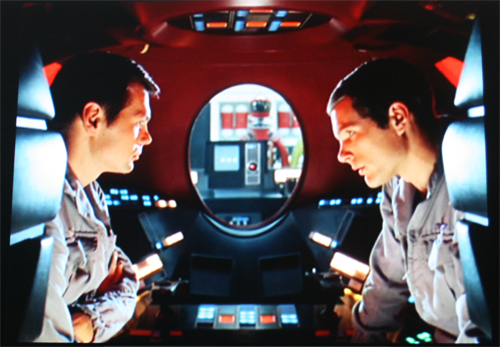
Well, no wonder Domino was reluctant to put it "into words," her profile reminds distinctly of Dave Bowman conversing with Dr. Frank Poole in the pod as HAL looks on, reading their lips in 2001.
And lo and behold, after a pause, as we all wait for Bill's answer, at 52:05 Bill's cell phone rings. As with Marion, as with the floral shop, once again things are "Nipped in the Bud". Domino stops smiling, as if aware of what is coming, who is calling Bill, who is interrupting their transaction, just as Bill's conversation with Nick had been interrupted and his conversation with Gayle and Nuala had been interrrupted. She closes her eyes then opens them again. Bill turns his face away.
The television in Domino's apartment may be the same make of television that is in Bill and Alice's kitchen, as if uniting these places, or acting as a kind of HAL's eye between them. I am reminded of the several view from the kitchen window paintings about the apartment showing a tree in different seasons.
183 MS Domino's bedroom from the rear of Bill. (52:15)
Cut to show Bill seated on the bed covered with a Tree of Life bedspread, Domino leaning over him.
BILL (rising): Excuse me.
Bill rises, turns down the music on the stereo, gestures for the woman to be quiet (his finger to his lips), answers the phone. This takes us back to the opening of the film wherein we heard the Shostakovich waltz and as Bill and Alice left their bedroom Bill cut off the stereo which is when we realized the Shostakovich was supposedly playing on it.
As he has crossed to the phone, we've seen on the carpet a variation of the S-curve which sometimes appears, this time more a wave.
Pastel colored Christmas lights drape the walls around the windows that give us a view on impossible skyscraper lights.
Introducing Sociology, the study of human behavior, is one of the books on the prostitute's dresser. One can assume the prostitute is a student of sociology at NYU.
We should also see in this the etymology of "social" relating to friendliness and geniality. From the Online Etymology Dictionary:
c.1500 (implied in socially), "characterized by friendliness or geniality," also "allied, associated," from M.Fr. social (14c.), from L. socialis "united, living with others," from socius "companion," probably originally "follower," and related to sequi "to follow" (cf. O.E. secg, O.N. seggr "companion," which seem to have been formed on the same notion; see sequel). Meaning "living or liking to live with others, disposed to friendly intercourse" is attested from 1729. Meaning "pertaining to society as a natural condition of human life" first attested 1695, in Locke.
Bill had just had a rather harrowing encounter with the college Yalies. Then Domino, who lives next to the Lotto store (indeed the Lotto store is apartment 2, apartment 2 not existing, a door from Domino's apartment even leading into it) takes Bill in with the offer that it is nicer in there than on the street. The story is one of prostitution but we have more going on.
The other book, viewed directly under a mirror, is Shadows on the Mirror. I had always thought it would be a psychology book. Instead it's a kind of thriller about a female lawyer whose husband was unfaithful, then when widowed she goes about having (it seems from the description) brief affairs with men, restoring their confidence in themselves. But one "vicious misogynist" of a client stalks her, and "keeps her under surveillance as a possible replacement for his missing wife". So, this is a book that shares with Eyes Wide Shut an unfaithful husband. Though Bill is only potentially unfaithful. The plot of Shadows on the Mirror may suggest that if Bill sleeps with Domino it would be a matter of restoring his confidence.
But another thing to consider is that Chris Isaak's "Baby did a Bad Thing" came off the album "Forever Blue" which also had the song "Shadows in a Mirror". The lyrics have two lovers who have split up, one hoping that they will get together again, but the shadows in a mirror tell the person they're wrong and that they are instead finished.
In the movie Helen of Troy, that we had seen at the Harford apartment, when first meeting Paris, Helen presents herself as a slave of Helen, he having mistaken her for a beautiful slave. She speaks of herself as Helen's "shadow". The movie continues with the idea of dual personas for both Paris and Helen. But Helen is also, in reality, depicted as a slave in her unwilling marriage with Menelaus, her freedom attained through her love for Paris.
The shadow in the mirror reminds also of Helena's reading the poem at bedtime in the presence of her parents: "I have a little shadow that goes in and out with me, And what can be the use of him is more than I can see. He is very, very like me from the heels up to the head; And I see him jump before me, when I jump into my bed."
BILL: Hello?
184 MS Alice at the kitchen table. (52:31)
It's Alice. Bill asks if everything's all right and she says yes, she was just wondering if he was going to be much longer. He says it's difficult to talk right now (he had choked and stuttered as he stood with Domino in front of her building, Domino had said she would prefer not to "put it into words") but it could be a while, he doesn't know how long, they're still waiting for some relatives to arrive. Back at the Harford apartment, on the television screen, Nina, in a yellow coat and white boots, walks off into the night with George Segal. Alice says she's going to bed.
ALICE: Hi.
185 MS Bill. (52:33)
BILL: Hi. Is everything all right?
186 MS Alice. (52:36)
ALICE: Yeah. I was, uhm...I was wondering if you were gonna be much longer.
The shots of Bill and Alice parallel one another. The mirror is to the right of Bill on the phone, a portion of his reflection visible. With Alice, the television on her right acts as a mirror, reflecting the opposite window, her shadow on it.
Whereas the winged cherub (eros) card had dominated in the kitchen, when Bill is on the phone with Alice the St. Nick card dominates the scene. And Alice happens to be eating SnackWells Devil's Food cookies.
The wave on the carpet at Domino's is answered by the wave figure on the back of the individual's jacket on Alice's television screen.
187 MS Bill. (52:44)
BILL: Uhm, it's it's uh, it's a little difficult to talk right now. It could be a while.
188 MS Alice. (52:53)
ALICE: Any idea how long?
189 MS Bill. (52:56)
BILL: No. I, I don't really know. We're still waiting for some relatives to arrive.
190 MS Alice. (53:03)
ALICE: Uh, well, I'm, I'm gonna go to bed now.
191 MS Bill. (53:09)
BILL: Okay. Bye-bye.
If one hasn't read my notes on Alice and Helena watching the "Fright before Christmas" cartoon in the second section, that scene has a great deal to do with this one. Kubrick uses the embedded television as a kind of commentary, and the "Fright Before Christmas" refers to this scene in several ways. Bugs Bunny serves the Tazmanian Devil (doubling as Santa Claus in the cartoon) milk and cookies and offers him devil's food cake, just as we have here Alice eating the devil's food cookies and drinking milk. The idea in the cartoon is the Tazmanian Devil (accidentally) masquerades as Santa. When he's in his "shadow" state (covered head to foot with soot) he's indeed briefly mistaken as Santa, but when the soot is removed Bugs recognizes him and sets about trying to get rid of him. On the breakfast table before the television set in the Harford kitchen was the "I Can't Believe it's not Butter" tub and above it a painting with an homage to Vincent Van Gogh's sunflower paintings with duplication of them in the painting. What is the real thing and what is the fake? I can't believe it's not butter. Taz as the fake Santa Claus.
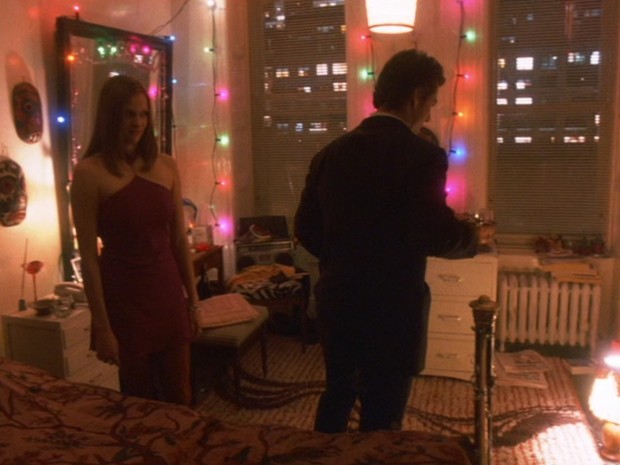 183 |
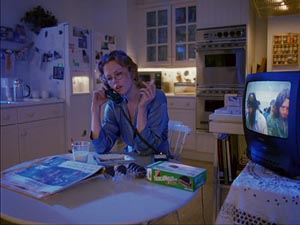 184 |
 185 |
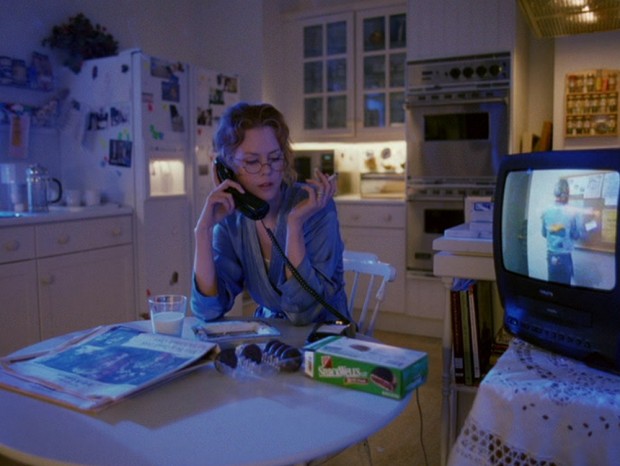 186 |
 187 |
 188 |
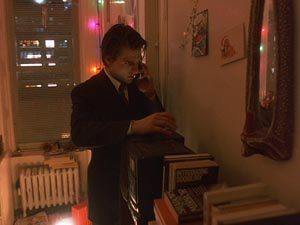 189 |
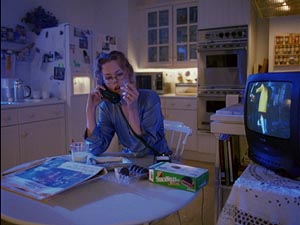 190 |
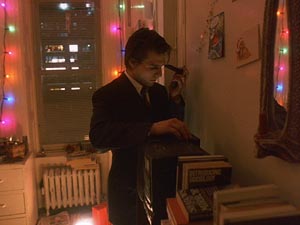 191 |
|
Notice that the shots in which blue stands out are those that are on the female side of the back-and-forth dialogue sequences. This held true during the argument with Bill and Alice, then Bill's visit with Marion, and now Bill's conversation on the phone with Alice. Bill is backed by a window but Kubrick does not have the blue radiating the window of Domino's bedroom.
As for Blume in Love, this film was directed by Paul Mazursky, who was in Kubrick's Fear and Desire as a character who appears to go mad but is also an expression of The Tempest's Ariel, protean in nature, speaking of morphing from one form to another. The action at the beginning and end of Blume in Love is in Venice, Italy (displaying the same circularity that Kubrick does in Fear and Desire and Lolita) while the rest of the story takes place in Venice, California, which Kubrick would have tie in with the Somerton orgy with its Venetian masks. Venice, Italy is the idealized home, one of love and community. Venice, California is where everyday life is dealt with and where things go sour for Blume and Nina, they splitting up due his stated one act of infidelity committed while he has a cold--and, simultaneously, his wife, who shares the same cold, meets the man with whom she will become involved after her divorce, a musician (Kris Kristofferson), who comes to her welfare office looking for aid. Blume is reluctant to let Nina go, and becomes friends with the new boyfriend so a rather odd threesome develops (not sexually though at times there seems the potential). The impression is given eventually that Blume, influenced by Elmo, Nina's boyfriend, is attempting to really get to know Nina, to give her autonomy, to recognize her own personhood, to not own her. But there is also an element of control, of stalking behaviors, and Blume ultimately rapes her. Which is devastating. You like all the characters. You have perhaps come to like Blume or have perhaps liked him from the beginning, George Segal portraying him empathetically and yet also as a person who is is alarming. You want things to go well for them. For them to be friends. And then he rapes her, convinced that she must still be in love with him and want to sleep with him. And the rape is devastating. You want Mazursky to take it back, you want it not to have happened. Consequently, Nina becomes pregnant. She has long wanted to have a child and welcomes the pregnancy. Elmo leaves, intimating to Blume that Nina still loves him. For nine months Nina and Blume do not see each other. Horrified by his actions, he accepts Nina's refusal to have anything to do with him, but does send her love letters, and during these months he seems to relinquish control of her, to come to see her as a person. In the end, in Venice, they reunite just before the child is born.
Shades of The Shining, Blume's wife-then-ex-wife, Nina, drives a yellow VW.
Mazursky punctuates the circularity of his film by showing at beginning and end the grafitti of an A enclosed within a circle. The A within a circle has been a symbol of anarchy since 1868 and after being adopted by an anarchist group in Italy in the 1960s was popular throughout Italy by 1968. Blume in Love was released in 1973, so the A in the circle that we observe fits the tumult of the time. Are we to assume that Mazursky includes the grafitti as an intentional reference to anarchy? I think it's likely as Mazursky seems to be saying that in true love there is equality and no ownership. Nina is not Blume's property, and the child will be also it's own person. At the end, as Nina goes into labor, she is still asserting her independence. She is not Blume's wife. Now, in Eyes Wide Shut, we will have Domino asking if on the phone was "Mrs. Dr. Bill". Outside a voice is heard saying, "No, no", while Bill says, "Yes, yes". Alice is not Alice, she is instead an extension of Dr. Bill, which is one of the problems they are facing. But the film, taken on a practical level of story-telling, rather than mystical, also condemns abuse of hierarchal power in general. I think we can safely assume that Kubrick meant his inclusion of Blume in Love to supply more than a few annotations on Eyes Wide Shut that aren't directly observed and can only be had through knowledge of tangential content, which is typical of Kubrick.
192 MS Domino reclining on the bed beside a tiger plush. (53:26)
Cut to the prostitute reclining on her bed, a stuffed tiger in the background (we will see a number of stuffed tigers in the final scene of the movie at the toy store where Bill discusses the possible meaning of his experiences).
DOMINO: Was that Mrs. Doctor Bill?
We hear outside a man saying, "No, no!"
193 MS Bill still standing by the stereo. (53:32)
BILL (turning to face her and walking toward her): Yes. Yes.
The background track of the voice saying, "No, no!" is left just loud enough that we are able to hear it. We could then take it as yet another participant in the dialogue. A kind of Greek chorus, perhaps. Domino asks if that was Mrs. Doctor Bill. The environment says, no. Bill says yes. so, what does that mean? One could wonder then if it was Alice or her "shadow in the mirror".
He sits on the bed.
We notice that there are tribal masks all over the walls. There had been a sculpted mask at the Nathanson apartment. Now there are at least five at Domino's, three beside the bed and two on another wall.
The Online Etymology Dictionary relates this as to the word domino:
1801, from Fr. domino (1771), perhaps (on comparison of the black tiles of the game) from the meaning "hood with a cloak worn by canons or priests" (1690s), from L. dominus "lord, master" (see domain), but the connection is not clear. Klein thinks it might be directly from dominus, "because he who has first disposed his pieces becomes 'the master.'"
We've already here an expression of the mask and the hood with the cloak that Bill will later don for the party. Domino, with her name, foretells the event.
194 MS Bill and Domino, the kitchen in the background. (53:47)
DOMINO: Do you have to go?
BILL: Do I have to go? I think I do.
DOMINO: Are you sure?
BILL: Yes, I'm afraid so. (Slaps his thighs then reaches in his jacket inner pocket.) But, listen. I want to pay you anyway. How much did you say it was? One hundred and fifty?
DOMINO: Yeah. But, you know, what, you don't have to bother about that.
BILL (having removed three fifties, putting back up his wallet): No, that's all right.
DOMINO: No, really, you don't have to.
BILL: No, I want to.
DOMINO: Really?
BILL (taking her hand and folding the money in it): Really.
DOMINO: Well, thank you, very much.
The one hundred and fifty is the same amount that will be the base charge for the rental of Bill's cloak and mask costume at Rainbow fashions.
Bill has taken his wallet out of his left jacket pocket (facing us). When he was dressing to go to the party he had put his white handkerchief in his left jacket pocket and his wallet in his right. When he arrives at Somerton, after paying the taxi driver he will slip his wallet into his inner right jacket pocket (facing us). When he pays at the Rainbow he will be again using the right jacket pocket for his wallet.
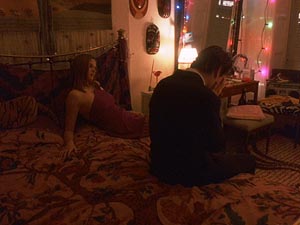 193 |
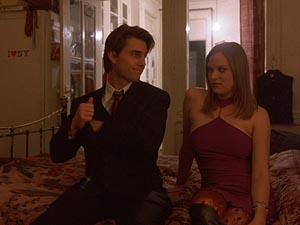 194 |
In the book, Mizzi insists on not taking Fridolin's money and he doesn't press the issue. They are not interrupted during their time together. At first, finding himself disinterested, he pleads weariness. She observes he's afraid and when he would prove he's not she refuses him, saying that "sooner or later it's bound to happen, you're quite right to be afraid".
EYES WIDE SHUT AND DEPALMA'S HI, MOM
COMPARISON OF HI, MOM WITH 2001 - THE TWO APARTMENTS - COMPARISON OF THE THEATER OF "BE BLACK, BABY" WITH BILL'S ORDEAL AT SOMERTON
December 2008, I was watching, Hi, Mom!, a 1969 film by Brian De Palma, starring Robert De Niro, and I realized there were some things in it in common (so it seemed) with Eyes Wide Shut.
One of the most notable things about the film is that the character Travis, from Taxi Driver, is already being developed in Hi, Mom! in which De Niro plays Jon Rubin, a Vietnam vet.
The story begins with Jon Rubin going to take a look at an apartment. He's an aspiring film maker and decides to rent the apartment because it gives him a good view of several windows in an opposite domestic high rise. His plan is to make a movie based on what he sees going on in the daily lives of the individuals in those apartments, voyeuristically filming them. In one apartment live 3 women, 2 who are always going out on dates, leaving the 3rd roommate sadly sitting at home, despondent and munching snacks--kind of like Alice sits at home munching snacks while Bill is out potentially philandering. In another apartment is a photographer whose primary interest seems to be seducing his models, filling them with alcohol then tackling them. A third apartment has a family with a wife/mother who is herself taking up filming. The fourth apartment's tenant is a white radical (NYU student) who is helping to stage a play titled Be Black, Baby.
Jon finds a producer but the producer is in porn so his movie is going to have to have porn elements which he eventually tries to manufacture by inserting himself as a character through becoming intimate, via a ruse, with the above-mentioned 3rd roommate, Judy Bishop. He hopes to film an erotic encounter with her, from his apartment, as it occurs in the window of her apartment.
Jon is kind of a little psycho. At first he comes off as nice and one is easily sympathetic with him, despite our better instincts that one should be wary of individuals who spend all day filming others on the sly. We like him as he's presented comedically and De Niro does a good job of making us like him. But what we learn about Jon is he doesn't develop personal relationships. He has ideas that he makes happen and concocts a character that he enacts rather than living through it, anticipating a passage from The Urban Guerrilla, which he will later read aloud, on the success of para-military operations being dependent on the individual who assimilates himself so seamlessly into bourgeois society that he is indistinguishable from those whose ideology and lifestyle he seeks to destroy.
First he films life as it happens...to other people. Then he fabricates the identity through which he can enter the life of Judy Bishop for the purpose of his film. Having plotted his seduction of her down to the second, Jon somehow rigs his camera to a timer so it will begin filming the seduction at a set time from his window, and he has a red light hooked up to all this so that the red light will be blinking on and off while the camera is filming and he will be able to see this from Judy Bishop's window, the window in which he'll be seducing her.
In any other movie, Jon would likely fall in love with Judy Bishop and then be faced with her discovering that their meeting was artificially staged, that he had been initially using her. She would refuse to see him and then they would probably make up and live happily ever after. But Jon blithely makes up one story after another, cavalierly manipulating Judy's emotions and carries through with his plan.
We have observed in previous scenes that Jon's tripod is unreliable and it doesn't now disappoint us. While the camera is filming the seduction, it pans down and ends up instead filming the radical in the below apartment as he paints his nude body black and photographs himself for posters for the play, Be Black, Baby! This equipment failure causes Jon to lose his producer.
Jon trades in his camera for a color television on which he watches revolutionary films made in black and white by an acting troupe, and there seems an abrupt transition in story line for now he tries out for the part of a policeman (an actor preferably with military experience) in Be Black, Baby!, which is to be put on by the same acting troupe which has been filming the revolutionary movies.
There follows a film within a film of the play which forces the audience through horrific real life experiences of rape and beatings so that they "live black" and think these experiences are real life instead of part of the play. The white audience first feels the black cast members for differences between whites and blacks, then must eat as they eat (black eyed peas, pig's feet etc.). One woman in particular protests that she is a member of the audience and uncomfortable with this, referencing the wall between audience and cast, but is told she must do what they ask as part of the play. This has all been preparation for the show which they'll experience when finally living black. The black cast members appear with faces painted white and paint the faces of the white audience black (including the face of a black audience member). The cast members say they must now, as white people, get to know the black people (the audience), being friendly, as white people like to know black people. As they are going up to the "next level" they take the purse of one woman who had protested the loudest. One of the men attempts to get her purse back and is beaten. The woman, living black, is raped by a cast member. All are convinced this is real life when a policeman (Jon Rubin) appears on the scene but insists on taking away one of the black-painted white cast members instead of the true assailant. Then at the end they exit the theater and are abruptly leaving the play and are being thanked for coming. It's the erasing of the wall between audience and stage in the manner put forth in Antonin Artaud's "Theater of Cruelty" manifesto. Based in ritual, this may sound like a winning way of transformation, and was intended to be a vehicle for transformation, but the audience, if they subsequently purchase a premise which can't be reasonably submitted to beforehand (when one doesn't know to what one is submitting) and accept abuses as acceptable that they otherwise likely wouldn't, then...well...that's problematic, isn't it.
Instead of responding with rage, while in a state of shock, the audience accepts the idea that they are unable to rebel against the experiences of Be Black, Baby! as it was theater and they were manifestly agreeable by way of purchasing a ticket. They enthuse about how real and great their experience was and that they will even recommend their friends come and see the production.
The actors remark on how the audience hadn't learned a thing.
But there's really not so abrupt a transition as all that for it's when Jon crosses the line and begins acting in his own movie, filming his stagings rather than real life, that we have the camera moving from filming him to filming the actor who painted his body black. Jon's actions have made a virtual Theater of Cruelty around him, except those he draws into it aren't aware of any part of their life being staged.
Anyone who can imagine being watched, who has that third, critical eye examining them, may become an actor playing for that third eye. As we've seen in this film, most every character is involved with the camera, with staging, setting a scene and recording it, which could be a statement on art or have to do with the psychology of the relationship with that all-observing, critical eye.
Be Black, Baby invites an audience, gradually introduces then forces that audience into participating in the play rather than observing, then when they step outside the theater they are suddenly removed from the play and, confused over what is staged and what is real, accept their traumas and humiliations as scripted. For the period of time in which they are pummeled by what may or not be real life, boundaries seemingly annihilated, they have no control and can't reason in their usual fashion with their own critical eye. The rug pulled out from under them, they all recognize and accept what is happening as real life, as authentic (just as Artaud intended to generate authentic, sensational experience through the Theater of Cruelty) and some heart-rending, authentic-sounding screaming comes of it. Then the rug is pulled out from under them again and they are told this was theater, the critical eye is reestablished, repositioned and they accept the experience as some sort of mutual relationship which had adequate boundaries that they simply didn't understand at the time.
Indeed, and before I forget, a white actor in Be Black, Baby is at one point accused by his fellow actors of not participating. It's unclear but it seems he is a plant, in that he's an actor who is passed off as a member of the audience. And what is his response? That he is taking notes for his review for Eye Magazine (which was a real magazine put out by Hearst from 1968 -1969).
The plot of Stanley Kubrick's Eyes Wide Shut is a variation on all this. Tom Cruise, as Doctor Bill, learns of a high end party. He is warned away from it but goes and sees what he believes to be bizarre ritual goings-on, the identity of everyone concealed by masks. Churches typically rope off from the masses initiation experience with a good deal of preparation, and the initiate usually wonders what the "about" was, what was the big deal, as it is largely intellectualized, which is part of what Artaud was rebelling against, and in Eyes Wide Shut Bill is presented as (at least on one level of discussion)--without authorization or education--broaching a sort of secret church, crossing boundaries, and thus having to suffer the consequences. His mask is stripped and he believes his life is threatened. (Masks protect the individual, allowing the operation of archetype or spirit of a traditional, established nature to operate exempt of personal judiciary.) Bill's experience comes at a price. One of the prostitutes steps forward and announces she will serve as his substitute, then the next day he learns of a woman who has been found dead of an overdose, and believes it to be the same woman. What was real and what wasn't is the crux of the conversation Bill has toward the end of the film with Ziegler, who had been at the same party. Ziegler says Bill should never have been there and that what happened was simply playacting in order to terrify him into keeping his mouth shut. Yes, he says, the prostitute did die, but her death had nothing to do with him or the party.
Theater or real life?
Why do I even bring up Hi, Mom?
Because of Jon Rubin's apartment.
It was difficult for me to grab some photos of Jon Rubin's apartment from Hi, Mom! as there's a lot of quick cutting and we never get a good full view of it, but one enters a kitchen area where to the right is a bathtub and sink on the side, both with rolled lips, wainscoting on the wall behind, cupboards above. The kitchen has both a window and a door in it leading to the one other room in the apartment.
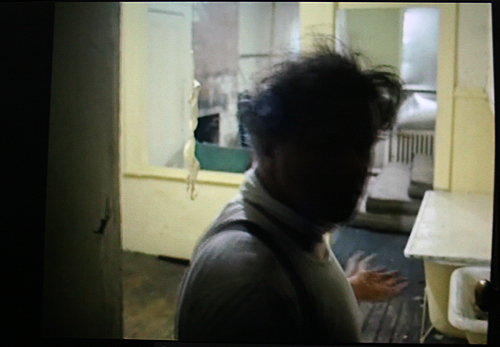


Now compare that apartment to Domino's. We have the same kitchen area with the bathtub and sink on the right, both with rolled lips, wainscoting on the wall behind, cupboards above. The kitchen has both a window and a door in it leading to the prostitute's bedroom. There had been a bra hanging from the light fixture in the apartment in Hi, Mom! and here there are bras hanging over the bathtub.
I know there are a number of apartments in New York where the bathtub is in the kitchen but you don't often see them in movies and it's the combination of elements, not just the bathtub and sink but the look of them, the placement, the cupboard, the wainscoting and the door and the window looking into the next room, the layout of all of it that leaped up and shouted, Eyes Wide Shut!. The similarities seem so stark to me, one could wonder (at least I could) if Stanley Kubrick's apartment set was referencing Jon Rubin's apartment in Hi, Mom! Especially taking into consideration the plots of the two movies and the confusion as to what is real and what is contrived.
But why? That has to be asked. Why reference Tom Rubin's apartment?
I have noted above that the doctor's encounter with the prostitute reminds me of a scene in 2001.
The prostitute's profile reminds me of Dave Bowman conversing with Dr. Frank Poole in the pod as HAL looks on, reading their lips in 2001. The prostitute had said to Bill she didn't want to put things into words, then just as they kiss, Bill's cell phone rings and it is as if the all-knowing eye, the eye of lip-reading HAL, intruding.

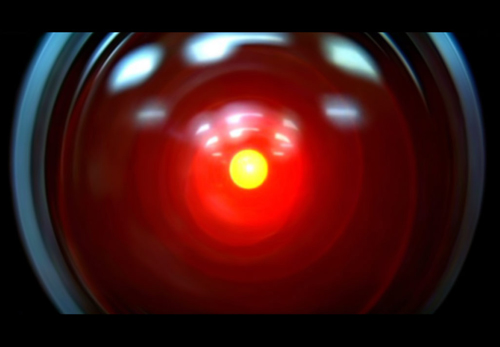
We have the same red eye with the red light blinking in Jon Rubin's apartment as the connected camera films his erotic encounter with Judy Bishop, which is interrupted by the camera lowering and focusing on the man painting himself black for, Be Black, Baby.


Of course, all-seeing, lip-reading HAL goes kind of crazy and kills Poole and his "consciousness" needs to be disengaged, at which point Bowman discovers the truth of his mission. But HAL was kind of engineered to go crazy (crazy by our human point of view) and Bowman was the man to cut HAL off, thinking it was equipment failure, and continue on to encounter the obelisk.
In Hi, Mom! the equipment failure of the camera renders Jon without a producer so he sells his camera and buys a television and goes on to act in Be Black, Baby.
What happens next with Bill? He meets Nick, finds out about the party, gets his black costume and mask and off he goes to what may be only theatrical or real, that is the whole debate on which the end of the movie hinges.
* * * * * * * * *
A note here on how Hi, Mom! plays out to the end, which needn't be read, I just wanted to make a record of it for myself. Jon later watches on the television as the revolutionary acting troupe tries to effect their own revolution by storming the apartment building in which live the white actor and Judy Bishop, but the troupe is ineffective and cut down while Jon reads that most revolutionary groups are crippled by government infiltrators so the task rests on the individual who assimilates himself so seamlessly into bourgeois society that he is indistinguishable from those whose ideology and lifestyle he seeks to destroy.
Announcing his new identity to us as insurance-selling, Harry Jameson, he goes on to marry Judy Bishop then does away with this husband role on the day that he announces he's sold a policy to his friend Harry Jameson (a little twist to ponder) who told his supervisor how good he was which made his supervisor nervous as if he was bucking for his position, the same day that pregnant Judy asks for a dishwasher, which is when he takes the laundry down to let her rest (until they get some "colored help") and blows up the apartment building with some dynamite in the laundry room. Then Vietnam Vet Jon Rubin situates himself to be interviewed by a news crew at the site of the explosion, the building pulverized, identifying himself as a demolitions expert and that he believes it was clearly a professional job. The newsman interrupting a subsequent tirade, Jon asks if he can say hello to his mother and looks at the camera and smiles and waves, "Hi, ma!"
tl;dr. I know what happens! Bill is outed as gay and tries to sleep with a prostitute to prove he's not but doesn't 'cause he's gay.
Actually, the first three sections have a lot to do with priming the viewer on the threads of symbolism that compose the intricate weave of the film, and, if one pays attention to them, will take the audience member into a deeper experience of the film and its maze qualities.
Approx 15,200 words or 31 single-spaced pages. A 116 minute read at 130 wpm.
Next: Go to Eyes Wide Shut Analysis - Part 4
Go to Table of Contents for Analysis of Eyes Wide Shut
Link to the main TOC page for all the analyses


